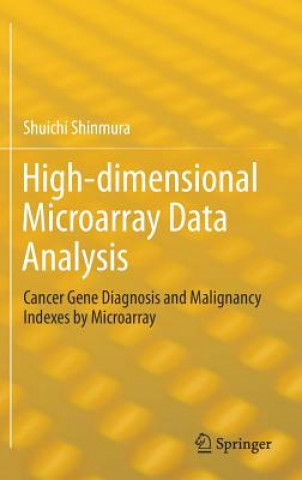
Kod: 21046175
High-dimensional Microarray Data Analysis
Autor Shuichi Shinmura
This book shows how to decompose high-dimensional microarrays into small subspaces (Small Matryoshkas, SMs), statistically analyze them, and perform cancer gene diagnosis. The information is useful for genetic experts, anyone who ... więcej
- Język:
 Angielski
Angielski - Oprawa: Twarda
- Liczba stron: 419
Wydawca: Springer Verlag, Singapore, 2019
- Więcej informacji o książce

727.42 zł

Dostępna u dostawcy w małych ilościach
Wysyłamy za 12 - 15 dni
Potrzebujesz więcej egzemplarzy?Jeżeli jesteś zainteresowany zakupem większej ilości egzemplarzy, skontaktuj się z nami, aby sprawdzić ich dostępność.
Dodaj do schowka
Zobacz książki o podobnej tematyce
-

The Black Robe
70.56 zł -

Egon Schiele
85.28 zł -7 % -

Random House Roget's Thesaurus
36.34 zł -9 % -

My Coffee Love Story: True Love from Coffee Art? Is It Possible?
36.54 zł -

Innovation in the European Insurance Industry
119.40 zł -

Genomic Diversity of Bacillus-Related Species
239.62 zł -22 % -

Surviving Digital Disruption: The 7-Step Digital Marketing Strategy to Futureproof Your Brand on the High Street and Online
66.09 zł
Podaruj tę książkę jeszcze dziś
- Zamów książkę i wybierz "Wyślij jako prezent".
- Natychmiast wyślemy Ci bon podarunkowy, który możesz przekazać adresatowi prezentu.
- Książka zostanie wysłana do adresata, a Ty o nic nie musisz się martwić.
Więcej informacji o High-dimensional Microarray Data Analysis
Za ten zakup dostaniesz 420 punkty
 Opis
Opis
This book shows how to decompose high-dimensional microarrays into small subspaces (Small Matryoshkas, SMs), statistically analyze them, and perform cancer gene diagnosis. The information is useful for genetic experts, anyone who analyzes genetic data, and students to use as practical textbooks. Discriminant analysis is the best approach for microarray consisting of normal and cancer classes. Microarrays are linearly separable data (LSD, Fact 3). However, because most linear discriminant function (LDF) cannot discriminate LSD theoretically and error rates are high, no one had discovered Fact 3 until now. Hard-margin SVM (H-SVM) and Revised IP-OLDF (RIP) can find Fact3 easily. LSD has the Matryoshka structure and is easily decomposed into many SMs (Fact 4). Because all SMs are small samples and LSD, statistical methods analyze SMs easily. However, useful results cannot be obtained. On the other hand, H-SVM and RIP can discriminate two classes in SM entirely. RatioSV is the ratio of SV distance and discriminant range. The maximum RatioSVs of six microarrays is over 11.67%. This fact shows that SV separates two classes by window width (11.67%). Such easy discrimination has been unresolved since 1970. The reason is revealed by facts presented here, so this book can be read and enjoyed like a mystery novel. Many studies point out that it is difficult to separate signal and noise in a high-dimensional gene space. However, the definition of the signal is not clear. Convincing evidence is presented that LSD is a signal. Statistical analysis of the genes contained in the SM cannot provide useful information, but it shows that the discriminant score (DS) discriminated by RIP or H-SVM is easily LSD. For example, the Alon microarray has 2,000 genes which can be divided into 66 SMs. If 66 DSs are used as variables, the result is a 66-dimensional data. These signal data can be analyzed to find malignancy indicators by principal component analysis and cluster analysis.
 Szczegóły książki
Szczegóły książki
727.42 zł
- Pełny tytuł: High-dimensional Microarray Data Analysis
- Podtytuł: Cancer Gene Diagnosis and Malignancy Indexes by Microarray
- Autor: Shuichi Shinmura
- Język:
 Angielski
Angielski - Oprawa: Twarda
- Liczba stron: 419
- EAN: 9789811359972
- ID: 21046175
- Wydawca: Springer Verlag, Singapore
- Waga: 834 g
- Wymiary: 235 × 155 × 30 mm
- Data wydania: 24. May 2019
Ulubione w innej kategorii
-

Dune
35.33 zł -33 % -

Haunting Adeline
125.29 zł -2 % -

Berserk Deluxe Volume 2
148.85 zł -31 % -

White Nights
16.03 zł -20 % -

Powerless
44.77 zł -19 % -

Atomic Habits
80.31 zł -19 % -

Dune Messiah
32.18 zł -33 % -

Berserk Deluxe Volume 3
221.96 zł -

One Day
32.89 zł -36 % -

Berserk Deluxe Volume 1
213.53 zł -2 % -

Iron Flame
61.62 zł -28 % -

Surrounded by Idiots
51.57 zł -19 % -

Harry Potter and the Prisoner of Azkaban (Minalima Edition)
171.80 zł -2 % -

Gravity Falls Journal 3
89.75 zł -1 % -

Heaven Official's Blessing: Tian Guan Ci Fu (Novel) Vol. 1
89.65 zł -1 % -

The Creative Act
101.02 zł -15 % -

Dune
38.37 zł -38 % -

Hunting Adeline
131.18 zł -1 % -

A Little Life
48.93 zł -12 % -

Children of Dune
47.11 zł -2 % -

Heaven Official's Blessing: Tian Guan Ci Fu (Novel) Vol. 2
96.55 zł -

Bungo Stray Dogs, Vol. 8 (light novel)
69.85 zł -

Percy Jackson and the Olympians 5 Book Paperback Boxed Set
194.64 zł -1 % -

Solo Leveling, Vol. 1
89.24 zł -1 % -

The Prisoner's Throne
41.32 zł -19 % -

Court of Thorns and Roses
41.32 zł -19 % -

Cry Baby Coloring Book
48.63 zł -

Fourth Wing
68.53 zł -19 % -

Icebreaker
34.41 zł -28 % -

Berserk Deluxe Volume 6
190.68 zł -13 % -

Avatar, the Last Airbender: The Kyoshi Novels (Box Set)
170.58 zł -2 % -

The 48 Laws of Power
102.04 zł -13 % -

House of Leaves
86.50 zł -32 % -

Twisted Lies
37.05 zł -28 % -

Dune Messiah
47.92 zł -23 % -

No Longer Human
69.24 zł -

48 Laws Of Power
82.03 zł -19 % -

Twisted Games
44.77 zł -19 % -

Caraval Paperback Boxed Set
176.97 zł -3 % -

Solo Leveling, Vol. 2
85.49 zł -6 % -

Open Circuits
170.98 zł -2 % -

Berserk Deluxe Volume 5
219.62 zł -

Heaven Official's Blessing: Tian Guan Ci Fu (Novel) Vol. 3
73.50 zł -19 % -

Berserk Deluxe Volume 4
223.38 zł -23 % -

Court of Mist and Fury
41.32 zł -19 % -

SOLO LEVELING V08
89.14 zł -2 % -

English File Upper Intermediate Multipack A (4th)
93.81 zł -1 % -

CHAINSAW MAN V14
43.75 zł -22 % -

Before the Coffee Gets Cold
44.77 zł -19 %
zadowolonych klientów
Od roku 2008 obsłużyliśmy wielu miłośników książek, ale dla nas każdy był tym wyjątkowym.
Copyright! ©2008-24 libristo.pl Wszelkie prawa zastrzeżonePrywatnieCookies


 21 milionów książek
21 milionów książek Dostawa 10.99 zł
Dostawa 10.99 zł (32) 444 93 66 (8-15.30h)
(32) 444 93 66 (8-15.30h)